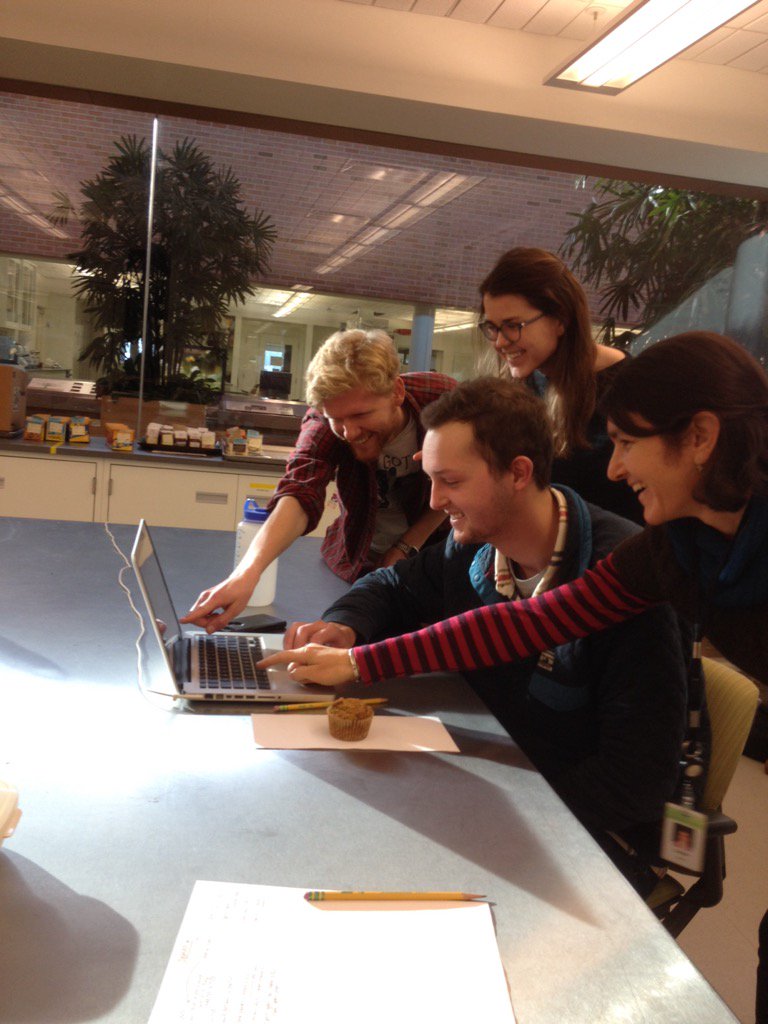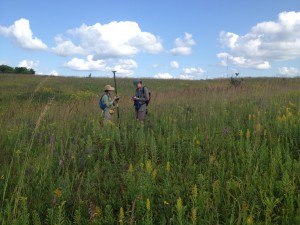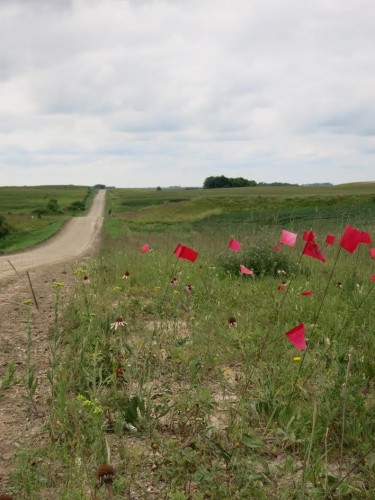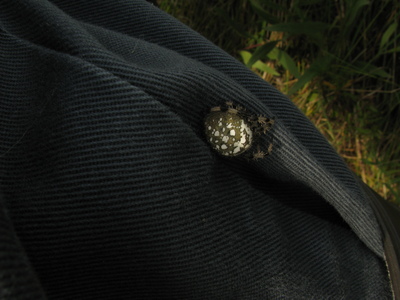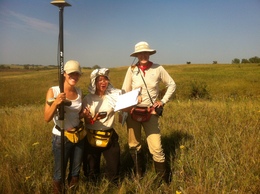|
|
Hi Flog! It’s me, Amy!
This winter we’ve been working on ‘demap’, a project to coordinate 20+ years of demography and spatial data from remnant populations of Echinacea in Solem Township. When we are done we will have a great long-term dataset of over 3000 individuals in 27 remnant populations. We can use that information to answer all kinds of questions about flowering dynamics in natural populations, population growth, and the consequences of disturbances such as habitat fragmentation and fire! In particular, this January we focused our efforts on answering questions about the demographic consequences of fire. Does fire’s stimulation of flowering contribute to increased population growth over the long term? Do reproductive benefits of fire outweigh potential survival costs? We’re not sure, but we hope to find out by analyzing four populations– a large population that had one fire event, a large population that has not been burned in the past 20 years, a small population that burned once, and a small population that has not burned in the past 20 years. We’ll combine our demography data about flowering and survival with other information, such as the seedling recruitment and remnant seed set data, to project population growth.
Will was here to help out with the project in the first two weeks of January. We got a lot done with demap and made meaningful progress on other big questions such as “Is kale overrated?” and “What does overrated mean statistically?”. We also made big strides in terms of professional development by studying business mogul DJ Khaled’s keys to success. Stay tuned for updates!
Sincerely,
Amy
 Demap is a team effort! In this shot, we are helping Will find a plant on the computer.
Today was probably the coldest day of fieldwork we have had all summer, a cold front passed through on Wednesday and left us with a cloudy 60 degree day. For those team members who are more accustomed to hotter summers today was a little bit of a shock.
We went out to do total demography at Staffanson Praire Preserve, our goal while doing total demo is to census all of the plants that have flowered sometime in the last 20 years. It’s a big project, at Staffanson alone there are just over one thousand locations to visit. While not all of these locations still have a plant it is awesome to see a tag around a plant that was put there in 1996 or 1997.
 Even the flowers are cold! We made a huge dent in the number of locations at Staffanson, of the 1054 locations we visited 435, nearly half done!
 Scott stakes locations while Amy does demography on the plants at each location
Here is a proposal for a fun project. It involves using demography data from this (and prior) years to estimate the growth rates of each of the remnants individually. Actually, that’s basically the whole project. Action items for the next month include: reading technical manuals with specifics on implementing aster models (see the list of project publications if you want to read them for me on your own).
scott_proposal_1
In other Scott-research related news, I will also try modeling fitness of various Hesperostipa spartea crosses in experimental plot 1. Just today I got a list of positions of plants found alive in 2016 — my plan in the near future is to search positions in the plot where plants were found alive in 2011 but weren’t found in 2016 to assess mortality. Keep your eyes open for another action-packed research proposal for this porcupine grass-ey project.
We were curious about the average sizes of our various remnant populations so I did some quick calculations and created this csv. As you can see, landfill is quite large with a median of 315 individuals found per year, whereas sites like dog and mapp are tiny, with only 3 plants found per year. At dog, to the best of our knowledge, there are only 3 Echinacea to be found, so we have regularly gathered demographic info on all of them. It’s important to note that these numbers are preliminary, rough estimates. Sometimes we have to redo a site during the summer so there will be twice as many records (hence the right skewed means), most of the time we focus on only finding flowering plants, but in some years at certain sites (e.g. landfill in 2005 and 2007) we’ve attempted to find every single individual whether or not it was flowering. All that said, here are some histograms showing numbers of demography records at each site per year:
demoSizeGraphs
In 2015, we continued to gather demographic information on Echinacea angustifolia in remnant prairie populations. We went to 32 remnant prairies ranging size from 1 flowering plant to 289 flowering plants. This year at our largest site, the Staffanson Prairie Preserve, we collected demographic information on 318 individual plants including 175 flowering plants. Across all the sites, we found 1561 flowering plants and visited a total of 1889 plants. For each plant that we visit, we record whether the plant is alive, whether the plant is flowering, and how many flowering heads it produces.
We currently have former team member Lydia English and current team member Will Reed working on organizing the previous 20 years of data using methods that Stuart, Jared, and Gretel developed last year. So far we have organized data from 2010-2015 (years we used GPS units) in 10 sites and data for all 1995-2015 for Staffanson Prairie Preserve.
Read previous posts about this experiment.

Start year: 1995
Location: more than 30 remnant prairies in and near Solem Township, Minnesota
Overlaps with: fire and flowering at SPP, flowering phenology in remnants
Products:
Wagenius, S. 2006. Scale dependence of reproductive failure in fragmented Echinacea populations. Ecology 87:931-941. PDF | Supplemental Material
Project “demap” – organized survey, demography, and phenology data.

With over 15 years of data, the study of Echinacea demography is among the Echinacea Project’s longest running research projects. During demography, Team Echinacea maps and collects basic demographic information about plants within 30 prairie remnants. In 2014 we collected demographic information for over 500 individual plants including 179 flowering plants at our largest site, Staffanson Prairie Preserve, alone. Across the other 29 sites, we found 897 flowering plants and visited a total of 1226 plants. For each plant visited, we recorded whether the plant was alive, whether the plant was flowering, and how many flowering heads it produced. With this extensive dataset, we hope to explore inter-annual flowering patterns, assess longitudinal plant fitness, and monitor numerical population dynamics in remnant populations of Echinacea.
Read previous posts about this experiment.
Start year: 1995
Location: 30 remnants prairies
Products: Stuart, Jared, and Gretel are working to clean, organize, and integrate demography, survey, and phenology data (project “demap”). Also see the demography protocol.
Overlaps with: fire and flowering at SPP
This afternoon the whole team ventured out to Staffanson prairie and collected demographic information on Echinacea plants. In addition to the 140 plants already flagged for phenology, we staked and collected data on roughly 200 additional plants!
While we put a substantial dent in the demography we need to do at Staffanson this afternoon, we still have a ways to go. Between 2010 and 2014 Team Echinacea mapped 1074 points, including 649 unique tag numbers. We will revisit all of these plants this summer in order to continue building a longitudinal demographic database.
I attached a graph to illustrate the temporal distribution of Echinacea tags at Staffanson. Note that all tags in the 19000s were placed in 2014, tags in the 18000s were placed in 2013, and tags in the 17000s were placed in 2012, etc. We have 410 unique tag numbers placed between 1996 and 2009 on our list of plants to stake!
sppDemoSummary.pdf
Today was a great day for Team Echinacea! After a quick morning of remnant phenology, we finished measuring Lydia’s Experimental Plot 09!!! On the Northwest Phenology Route, all flowering Echinacea at East Elk Lake Road and North West of Landfill have finished flowering. It is pretty cool to think of how long we have been returning to these sites for phenology, and now many of them are wrapping up (and quickly!). In the afternoon Elizabeth, Gretel, Jared and I were busy working on demography at East Riley, Riley, Railroad Crossing, and North of Railroad Crossing. Other team members went to KJ’s to look for seedlings that teams have been following in years past.
On the pollinator note comes a follow up from Steve Ellis’s talk with us last Friday. I recently came to learn that the city of Shorewood, MN has passed a law banning the use of neonicotinoids!!!! Shorewood now joins the all too small list of cities banning neonics, including Eugene, Oregon and Spokane, Washington. Although this is a small step towards protecting the bees, Shorewood has made a very important statement. Check out the Star Tribune article about the recent ban, along with a post on the Beyond Pesticides Daily News Blog!
http://www.startribune.com/local/west/269627281.html
Maria here.
Woke up this morning to some rumbling thunder in the distance.
The skies looked grey, but nothing too bad. We discussed how to do all the things we had to do at Staffanson: demo rechecks, harvesting Kelly’s Echinacea heads, removing twist-ties and flags from heads/plants that Kelly won’t harvest, figuring out 6 nearest neighboring Echinacea plants to each of Kelly’s plants that was going to be harvested, and pulling up ant traps. Whew!
We did some individual project stuff from 9 to 11am. Jill finished up sorting ants. Katherine and Kelly went to NWLF and NNWLF to pull ant traps and remove twist-ties from heads. I was in CG 99 South, measuring Dichanthelium from my maternal lines experiment, and got 4 rows done before 11am.
We set off for Staffanson, all 5 of us cozy in the truck. The corn and perennial weeds greeted us happily on the dirt road leading into Staffanson. Jill went to pull up her ant traps and then helped Kelly to remove twist-ties and flags. Stuart, Katherine and I brought out Sulu (the GPS), R2D2 (the netbook), and paper datasheets, and tried to figure out how to determine the 6 nearest neighbors to Kelly’s harvest heads. We concluded that the most efficient way was to use R to determine the 6 mapped nearest neighbors, obtain the distance to the 6th neighbor, then use a reel tape to measure out the distance and search to see if there are any other nearest neighbors closer than the mapped one. We would have to do it another day.
Here’s a fancy spider Stuart found on his knee today. Photo courtesy of Katherine.

On the way back for lunch, Stuart and Kelly belabored the pros and cons of color coding the top and bottom GPS poles.
After lunch we set out for Staffanson again. Kelly worked solo to harvest heads, while the four of us split into 2 teams (1 GPS + 1 clipboard) to do demo rechecks. After a little while, it started sprinkling and we heard some distant portentous thunder, so we turned back and left Staffanson.
Back at Hjelm House, Jill and Katherine cleaned up the ant traps and went to pull ant traps at Nessman. Stuart demonstrated dissecting achenes from Echinacea heads for Kelly, so she can dissect the heads she harvested when she’s at Carleton.
Lastly, as requested by Stuart, the “Sync Your Visor” song I came up with as an alternative to “Sync, Sync, Visor Sync”:
(To the tune of “Oh My Darling Clementine”)
Sync your visor, sync your visor,
Sync your visor everytime;
Data lost and gone forever
Don’t be sorry – sync it now!
Any suggestions for improvement are much welcome.
Happy Friday! Today was our fourth day “going solo” while Stuart is away in Chicago. In the morning, we finished up seedling searches at East Elk Lake Road. That’s two sites down! In the afternoon, we continued working on demography re-checks at some of the smaller sites. Basically, demography re-checks consist of fixing any errors that we might have made during the initial round of demography (i.e. one person said a plant had two heads while another said it had four), but it also allows us to go back and find basal plants that have flowered previously. By checking on these plants (or a random subset of these plants) each year, we can get a better idea of how often a plant flowers and the survival rate of flowering plants. Today we finished demography re-checks at Loeffler’s Corner (East and West) and Yellow Orchid Hill.
Here’s a picture of the crew at Yellow Orchid Hill after a hard day’s work:

|
|
